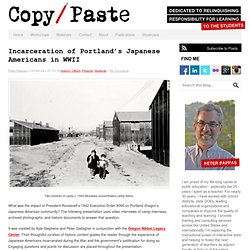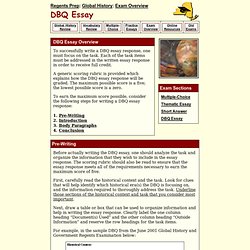

Great Debates in American History by Peter Pappas. History / DBQ’s » Archive. Incarceration of Portland’s Japanese Americans in WWII Two children in camp c. 1943 Minidoka concentration camp Idaho What was the impact of President Roosevelt’s 1942 Executive Order 9066 on Portland Oregon’s Japanese-American community?

The following presentation uses video interviews of camp internees, archived photographs, and historic documents to answer that question. It was created by Kyle Stephens and Peter Gallagher in conjunction with the Oregon Nikkei Legacy Center. Their thoughtful curation of historic content guides the reader through the experience of Japanese-Americans incarcerated during the War and the government's justification for doing so. The lesson features reaction to Executive Order 9066, temporary incarceration at Portland Assembly Center (built on the grounds of a former stockyard on the banks of the Columbia River), and the final destination for most of Portland's Japanese-American community - the Minidoka War Relocation Center in Idaho. Regents Prep Global History & Geography: DBQ Essay. In the 200 years since the Industrial Revolution began, the environment has been significantly altered as more nations industrialize and increase their manufacturing capacity to meet consumer demands.

For example in 1997 according to World Watch, carbon dioxide emissions in developed nations reached three tons per person, while developing nations produced half a ton per person (Document 2). These emissions can produce smog in concentrated areas, such as Mexico City, one of the most polluted cities in the world. Carbon dioxide can also form acid rain which can affect areas far removed from the source of the pollution. For example, pollution from areas of the United States has been carried into southeastern Canada causing acid rain which is detrimental to ecosystems and drinking water. Carbon dioxide has also been linked to global warming which can affect global weather patterns.
"FOR TEACHERS: Minding their DBQs. Tips for helping your students master Document-Based Questions." Guide to the New Standards. K-12 Education. New York State United Teachers. World Digital Library Home. Your History Site Writing DBQs. History Writing: DBQ Essays. While it’s true that DBQ (Document-Based Question) essays appear on the NY State Regents and AP History Exams, teachers—esp. history teachers—of EVERY grade should see them as a tremendous tool for teaching both content and critical thinking skills. The "DBQ Approach" is as follows: Give students multiple documents (including various sources such as letters, paintings, political cartoons, articles, and texts of speeches, among others) to interpret and use in response to a question.
Students must then build an ARGUMENT using the documents as EVIDENCE. Sound familiar? Indeed, DBQ essays require many of the skills involved in writing a research paper: close reading and analysis, inference, summarizing, and synthesizing ideas. But in this case, the teacher provides the research and the driving question. Here are a few sample questions from “DBQs Main Page,” an AP History Website that offers more than 70 student- and teacher-created DBQs, along with general Websites for DBQ research: HowTo_DBQEssayTeacher.pdf (application/pdf Object) Point! Click! Create! Create DBQ’s in 8 Minutes or Less. Boyer_dbq_teacher_guide.pdf (application/pdf Object) Using DBQs to Teach History. Document Based Questions, or DBQs, are gaining popularity among history teachers because they make it easy to incorporate primary sources rather than textbook articles into the classroom, and they also make up a good portion of high school Advanced Placement tests.
DBQs also ask students to synthesize information to answer a question, which is a skill all teachers want their students to know, making it a perfect activity for English or political science classes as well. What is a DBQ? DBQ stands for Document Based Question. It is a packet of primary source material - articles, stories, poems, pictures, quotes, and sometimes even videos - that all go with a certain theme or time period. At the top of these documents is a question that students need to answer using the source material in the packet. Dbq prewriting jordan.pdf (application/pdf Object) Create Your Own DBQ. You will be working in groups of three or four students each on this assignment. You will be expected to divide the work load equitably among yourselves and make a group decision regarding my evaluation.
You may choose to have the individual contribution of each member of the group evaluated separately or you may choose to have the final products evaluated as a whole with each member of the group receiving the same overall evaluation. Each group will be required to design a Document-Based Question dealing with an important historical issue during the years 1810-1860. You may not duplicate a question from a previous AP examination, nor one that has already been posted on the World Wide Web by another teacher, student or students. For an example of a DBQ created for the 2000 AP U.S. For a list of Possible DBQs for the 2002 AP U.S. "FOR TEACHERS: Minding their DBQs. Tips for helping your students master Document-Based Questions." Guide to the New Standards. K-12 Education. New York State United Teachers. Social Studies Central.